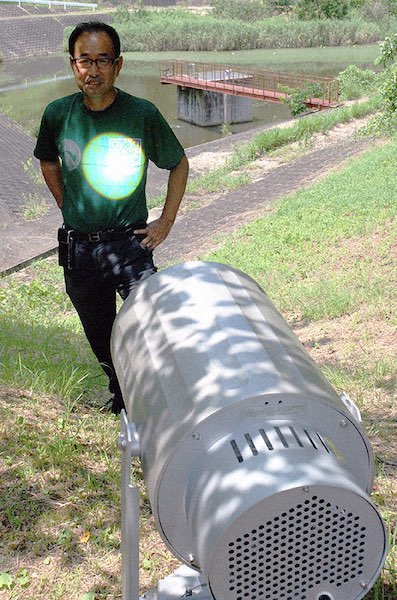Home
A comprehensive resource for safe and responsible laser use
Japan: Laser searchlight proposed to use QR codes to rescue hikers and climbers
The team, which is conducting the experiment at a campus in the western Japan city of Nara, has successfully scanned the two-dimensional code from a distance of about 300 meters and aims to put the system into practical use in the near future.
The code for the system measures about 11 centimeters (4.3 inches) on each side and is made from a retroreflective material. The print employs the same principle as that for reflecting road signs and can be scanned by a powerful laser searchlight.

A laser searchlight lights up a QR code on professor Yoshinobu Maeda's shirt at a Kindai University campus in the city of Nara. (Mainichi/Yasuhiro Okawa)
In responding to an actual situation, the team works on the assumption that a large laser emitter will be loaded on a helicopter to scan the mountain surface. The machine can spot a QR code from the light reflected from the ground. It's possible to identify a disaster or accident victim if their personal information, such as name and sex, has been registered with the code.
The system is being developed by a team consisting of scientists at the Faculty of Science and Engineering, and the Faculty of Architecture at the university.
Team leader Yoshinobu Maeda, a professor with the Faculty of Science and Engineering, said, "The system is technically advanced to a level where it can be introduced. The problem is how we spread its use. It's necessary for many people who enter mountain areas to wear clothes with QR codes and for helicopters to be equipped with laser searchlights."
From The Mainichi
Japan: Laser pointer safety symposium held
There were two main goals: 1) Raise awareness of problems caused by laser pointers and consumer lasers such as home cosmetic lasers, and 2) Try to find ways to mitigate and regulate these lasers, both for Japan and hopefully for other countries as well.
The symposium was sponsored by the Optoelectronics Industry and Technology Development Association. OITDA is a standardizing body developing the optoelectronics related standards which concern Japanese domestic standards such as JIS and the international standards such as ISO or IEC. OITDA also founds its own OITDA standards system that complements the domestic and the international standards.
The symposium was presented in the Roppongi Hills Auditorium, on the 49th floor overlooking the city and Mt. Fuji. There were approximately 40 attendees. Simultaneous translation from Japanese to English, and English to Japanese, was provided. There were four invited speakers:
- Professor Yuichi Hashishin of Kindai University spoke on "The current situation of the safety of laser pointers in Japan." He presented various cases and statistics about laser eye injuries and laser illumination of aircraft. For example, from 2012 through 2015 there were less than 40 pilot reports of laser illuminations in Japan, though this number did jump to 194 reports in 2016. He also was concerned about lasers being pointed at cars, trucks, buses, trains and other vehicles, feeling that perhaps a number of fatal automobile accidents were due to lasers but of course the victims could not confirm this.
- Next to speak was Patrick Murphy of LaserPointerSafety.com. He briefly reviewed current laser eye injury and pilot illumination concerns. He then presented suggestions for action, based on this page at his website.
- Dr. Martin Lindgren of the Swedish Radiation Safety Authority (SSM) discussed Swedish regulations concerning handheld lasers. He presented information on current problems, including that laser illuminations of pilots had risen from five in 2008, to around 140-150 from 2011 to 2015, with a decline to 62 in 2018. He described an ongoing 4-year research project to determine the probability of eye injury from handheld lasers at a distance; results may be available in 2020. Finally, he discussed Swedish law which includes a requirement for a license to own a handheld laser over 1 milliwatt.
- The final speaker was Atsutomo Hama of Nichia Corp., who presented "History of management of high-power laser diodes." Nichia sells high-powered multi-watt blue diodes used in projectors, lamps and other applications. Nichia wants to avoid these diodes being stolen or being removed from products so they can be put into hazardous handheld lasers. He described some of the methods Nichia uses, including a 2D code (similar to a QR code) put onto each diode to help track its manufacturing and sale.
There were a few questions for each speaker, but no additional discussion among the attendees. OITDA's Kenji Murata, who helped organize the symposium, indicated that there was additional funding for two more years.
Report by Patrick Murphy who attended the symposium as a guest of OITDA.
Japan: "Smartglasses" aim laser light directly into eyes
The laser is full color (red, green and blue combined) and is said to be harmless. The system was developed primarily as a vision aid for persons with visual defects. According to the news story, the image does not require focusing and is projected through the eye’s lens directly onto the retina.
The story notes that “the basic idea of projecting imagery onto a retina via laser has been around for decades, but miniaturizing the optics to realize a wearable form factor had been difficult until recently.”
A Fujitsu spinoff called QD Laser helped develop the glasses. They expect to begin selling them in March 2016 in Japan, Europe and the U.S. for about USD $2,000.
From PC World